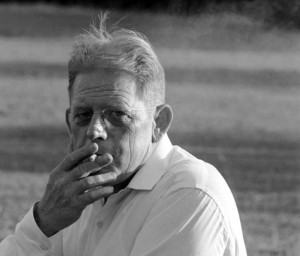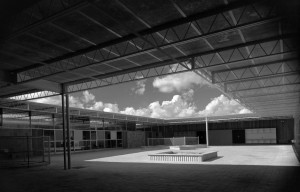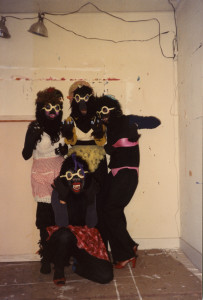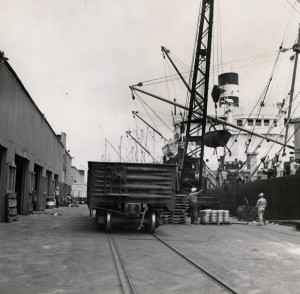
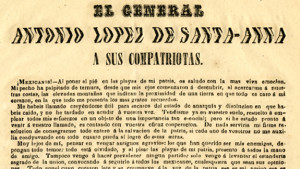
opening of message from Antonio López de Santa Anna to the Mexican people on his return from exile in Colombia, 1853 (from the Mexico Documents Collection)
As part of our Hispanic Collections, the Mexico Documents Collection is a small assortment of documents related to the government and people of Mexico, sure to provide some interesting research. The collection was assembled from another, larger collection of manuscripts and is available for study thanks to the generosity of a handful of donors.
Given the variety of the collection’s sources, what has emerged is a potpourri of papers dating back as far as 1570, running through the Texas Revolution, the Mexican-American War of 1846-1848, and extending as far forward as 1898. The documents run the gamut from dealing with the administration of states and territories such as Tamaulipas to communiqués and decrees from Antonio López de Santa Anna.
Researchers and scholars with fluency in Spanish should find these materials wholly approachable. However, for those whose Spanish may be limited, English translations are available for many of the documents. Information regarding provenance, when known, has also been included alongside the materials.
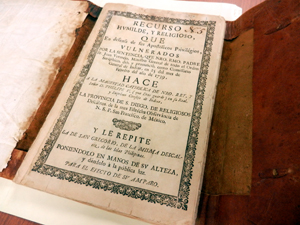
petition from the Barefoot Monks to Philip V, King of Spain (from the Mexico Documents Collection)
A detailed finding aid for the Mexico Documents Collection is available online and the collection itself remains open and available for study in the Special Collections Reading Room, at the University of Houston. No appointment is necessary and we look forward to assisting you with your research when you are ready to visit us.
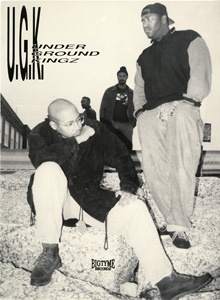
Underground Kingz (UGK), from the Houston Hip Hop Recording Artists Collection at the University of Houston Special Collections
The University of Houston Special Collections is pleased to announce that the finding aid for the Houston Hip Hop Recording Artists Collection has recently been published and is now available online. Incorporating a number of smaller collections donated by local rappers, DJs, businesses, and other members of the hip hop community, the Houston Hip Hop Recording Artists Collection contains promotional materials, photographs, and publications documenting the unique Houston hip hop scene from the 1990s through the present day.
Back in 1991 Chuck D was quoted as saying “Rap is CNN for black people,” expressing the frustrations of communities bewildered by the lack of attention or concern from the mainstream media. These untold stories would take root in freestyles, find themselves scribbled in notebooks, and performed on stages in front of audiences of different sizes and, eventually, different colors.
Music like hip hop, that establishes its presence organically outside of mainstream radio and record labels, is typically of interest in what it has to say not only in and of itself, but also what it has to say about the community from which it originates. Much in the same manner that scholars and researchers flocked to the study of jazz as a means of shedding light on the Great Migration of the early twentieth century, those interested in what CNN (and the others) missed along the way have turned to the study of hip hop. Unseen or unspoken in Chuck D’s quote is that hip hop became not only a national news network for otherwise uncovered topics, but it also became a local or micro news network, reflecting the specific anguish and joy of the individual communities which molded and shaped this genre to fit a particular need.
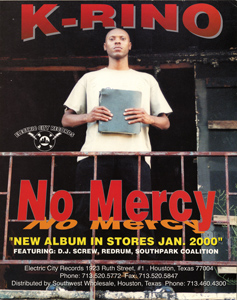
K-Rino, from the Houston Hip Hop Recording Artists Collection at the University of Houston Special Collections
While the hip hop scenes of the West and East Coasts have received most of the limelight (and now study), the hip hop scene of our Third Coast or Dirty South might find itself shortchanged. Our Houston Hip Hop collections help to fill that void, promising some exciting research potential. In looking at the Houston Hip Hop Recording Artists Collection, coupled alongside the DJ Screw Papers, researchers are able to gain an understanding of how and why this particular, regional scene evolved in the manner it has and the myriad of ways it differs from its brethren on either coast.
Please give the new finding aid a look and come visit us when you are ready to take advantage of these uniquely Houston resources.
The following comes to us from Dr. Stephen James. Dr. James holds a Ph.D. in Architectural History from the University of Virginia and for many years was a lecturer at the University of Houston College of Architecture. He began working with architectural archives at the University of Virginia Library, and at UH Special Collections he has been responsible for most of the Architecture and Planning collections, including Donald Barthelme, Sr.; Burdette Keeland , Jr.; and Doug Michels. He is currently working on the Kenneth E. Bentsen papers.
Many people are familiar with the work of writer Donald Barthelme but don’t know that he grew up in the shadow of his noted father, Donald Barthelme, Sr., a nationally prominent architect. Barthelme Sr. first attracted attention as the lead designer for the Hall of State at the Texas State Fairgrounds in Dallas (1936)—now considered a masterpiece of Art Deco. Twelve years later the American Institute of Architects honored him for his design for St. Rose of Lima Catholic Church in Houston (1948). Yet he made his reputation with his award-winning West Columbia Elementary School (1952), which was published widely.
Barthelme was a humanist who deplored architects’ fixation with aesthetics and style. Instead, he tried to enhance the physical experience of a building’s occupants. His innovative design for West Columbia dispensed with the long corridors of traditional schools by organizing the building around two large courtyards. Classrooms looked out on the courts through floor-to-ceiling glass, which admitted natural light and allowed views into the courts. Additional lighting came from large skylights. Courtyards and skylights were Barthelme trademarks and appeared in most of his buildings.
Throughout the 1950s, Barthelme was one of the best-known architects in Houston. A larger-than-life figure, he was a local celebrity who drove a sporty convertible and charmed the newspaper columnists. He cultivated the image of a loner who went his own way rather than follow the crowd. He had extremely high standards and insisted on doing things the “right way,” but this idealism sometimes alienated others.
Barthelme’s long relationship with the University of Houston began in 1946 as a member of the architecture department’s original faculty. He taught design and other courses there until his retirement in 1974, influencing countless students along the way. From 1959 to 1961 he was the chairman of the architecture department at Rice University.
Still, there was more to Barthelme’s life than architecture. In their modernist house off Post Oak Lane, he and his wife Helen Bechtold Barthelme nurtured five children in an atmosphere that encouraged creativity. Three of them—Donald, Frederick, and Steven—became important writers and, like their father, also mentored others. Donald was instrumental in the growth of the Creative Writing Program at the University of Houston, while Frederick and Steven have directed The Center for Writers at the University of Southern Mississippi. To learn more about this remarkable family, read Frederick and Steven Barthelme’s memoir, Double Down: Reflections on Gambling and Loss (1999). Further information about Donald Barthelme Sr. can be found in the Donald Barthelme Sr. Architectural Papers at Special Collections.
* Editor’s note: The original text of this post has been updated to more accurately reflect Donald Barthelme’s role in the UH Creative Writing Program.
The latest edition of Houston History Magazine features an article penned by our own Vince Lee, Archivist for the Carey C. Shuart Women’s Archive and Research Collection. In his latest piece, Vince takes a look at the much ballyhooed Houston Gorilla Girls and highlights the Houston Gorilla Girls Collection, available for study here at the University of Houston Special Collections. I spoke with Vince recently regarding the work behind the scenes that went into the article. His thoughts on the piece, and the Gorilla Girls as a whole, follow:
My impetus for writing the article, first and foremost, was to shed light on what I thought was an important and visually appealing collection. My hope in writing the article “From the Archives” on the Houston Gorilla Girls is to use the platform to talk more in depth about and provide increased awareness of the work that the Houston Gorilla Girls did in leveling the playing field for women artists in the Houston area.
I knew from the outset that the collection would provide many visual examples that would draw interest from potential researchers on what was contained-from masks and stuffed gorillas, to ephemera and photos from their demonstrations at local area art venues in which women were underrepresented as artists. If as a result of this, the article generates interest among researchers and students of art, women’ studies, and other interdisciplinary fields for further scholarly research and publication, then as an archivist I feel as if I have done my job.
The article itself wasn’t hard to write. All the ingredients were there from their records, photos, and ephemera. The Houston Gorilla Girls were very diligent and systematic about their own record keeping. It was just assembling what they had into a narrative to share their story and history with the greater public. If I had to sum up the Houston Gorilla Girls, I would say that they were a group of women fighting the good fight in gender equality, who took their cause seriously, but not themselves, and knew how to have a great time in the process.
It would appear his work on the article was also a great time in the process. Digital subscribers can read the article on Houston History’s website. Access to all those gorilla-themed weapons of gender and artistic liberation? Free of charge, as always, here at Special Collections.
Roll on, thou deep and dark blue Ocean – roll!
Ten thousand fleets sweep over thee in vain;
Man marks the earth with ruin – his control
Stops with the shore; – upon the watery plain
–Lord Byron, from Childe Harold’s Pilgrimage, canto II
In our youth, the world we inhabit is too large, too grand in our vision to fathom. As we grow older, we are amazed to find it shrinking and shedding some of its grandeur. We begin to find it more manageable, we devour it piecemeal, and dismiss the notion that anything was ever too large for us.
Occasionally, however, we are reminded.
The spectacles of nature remind us. The mysteries unlocked about ourselves remind us. Or, regardless of age, surveying a vast expanse of ocean and marveling at the unfathomable that envelops our little, blue rock, reminds us.
One of the joys of working with primary sources and artifacts of our past is that these seemingly small things still have the capacity to take us back there, remind us of how large and unwieldy the world is and how small but, at the same time, how significant and vital we each are. Recently the University of Houston Libraries received a communication from a patron conducting research in the Ship Channel Collection of our Digital Library. Upon discovering a photograph of an old friend, the SS Sue Lykes, she writes:
We can’t believe our luck at finding a photograph of the SS Sue Lykes in your collection. In 1954 the same vessel pictured unloading barbed wire on May 18th 1950 brought our family – Mother and three young girls – from London to Galveston (Dad had come over six months before on the Thompson Lykes and docked in the port of Houston. He had only just managed to earn the fare for us to come and wired it just in time to sail. We remember two other children on the ship, the Russian captain and several other passengers and crew. Lykes had very little, if any, cargo on board. The open expanded metal stairs were terrifying to climb and grandmother had to come behind us encouraging us up to the deck. We left London down the Thames, under the Tower Bridge and out to the sea – riding very high in a thick fog with the fog horn blasting – very exciting and frightening. It took us a month (approx. 15th November? to 16th December, 1954) to reach Galveston as we encountered an exceedingly violent North Atlantic storm, if not a hurricane. Bunk beds fell from the walls and my 6 year old mind wondered why the ship’s bow was going underwater. We upended a card table and slid across the cabin with the roll of the ship. I think there was some damage to the ship as repairs were made during the storm to something the first mate (who we liked because he gave us chocolate) had to scale. Veering southward towards the Azores to avoid any more difficulty, the ship crossed the Atlantic much further south than expected. Mom said she saw fires on the beach. We arrived in Galveston and saw that our Father was beside himself with worry. The ship had been out of contact. We know she has been scuppered and two or three have had her name by now, but we are so fond of that ship that brought us safely here.
With her recollection, an unassuming snapshot from the past is irreversibly altered. It becomes a reminder of the peril, wonder, and joy of youth — as well as the richness and warmth that comes through age and experience. As tiny as we can be, at times, we are still significant enough to bring about that sort of meaning and understanding to one another.
We thank our patron for sharing her story and take this opportunity to encourage you to do some exploration of your own — online or off. You never know what old friends you might find.
